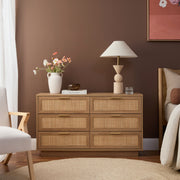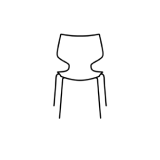11th July 2025
Beyond Seashells: Modern Coastal Design
Beyond Seashells: Modern Coastal Design
Coastal designs have evolved over the years, from collected seashells and bottled sand to clean lines and crisp contrasts. And so, the minimalist coastal style was born, offering a clean, modern approach to decorating your seaside home.
This new style provides an overall more sophisticated feel over the classic coastal design, offering a more contemporary touch to your interiors.
In this article, we’ll explore the concept and how to embrace it in your home.
Modern Coastal Evolution
Today’s coastal designs are all about airiness and natural-looking materials that offer clean lines and a sophisticated feel. The old cliche decor – anchors, seashells, and life buoys – has been sidelined in favour of more neutral decor.
Neutral tones and layered textures now take centre stage and offer a far cleaner aesthetic than the classical beach look.
So, when pursuing your own modern coastal design, the best place to start is with the furniture. Here’s how to choose foundation pieces for your home’s new look.
Foundation Pieces that Ooze Modern Coastal Style
Light neutral tones set the baseline for modern coastal designs. Colour is used far more sparingly. Muted blues and moody greens can still make an appearance and add an additional layer to your room design, but their addition should be planned carefully.
Textures, however, are still widely used to add boldness to the look. Rattan chairs such as the Mateo still add a lot to modern coastal dining areas. The texture and tone of the Amara dining table also makes for a great example of a foundational piece.
The same applies to furniture across the home, with textured, natural, or white furniture forming the foundation of your designs.
With foundation pieces selected, let’s dive deeper into sound colour strategy while modernising your coastal design.
Colour & Material Strategy
Modern Coastal makes use of narrower colour palettes, most often featuring soft neutrals, sandy beiges, warm taupes, and muted ocean hues. Given the modern element, white is often used as the foundation for these spaces.
To accent these narrow colour palettes and provide sufficient contrast to make a room “pop,” earthy greens, deep blues, or even terracotta can be used – but sparingly. These are only accent colours and when overused, can quickly ruin the modern touch and leave the room feeling a bit too classical.
Rattan and light wood look remain popular options for coastal furniture. For more sophisticated areas such as the evening dining room, blends of linen and rattan can add a classy feel, as present in the Avila dining chair.
Finally, sparing use of decor is a must. Overly bold colours in decor can add too much noise to a room, but a carefully placed bold design can add a welcome splash of colour to the narrow colour palette.
This is best used on a case-by-case basis and is not commonly seen in modern coastal design.
Room Transformations
From the living room to the bedroom and transitory spaces, each room should follow the basics of this style. However, each room should also cater ever so slightly to its unique purpose.
Living Spaces
You want your living spaces to feel open and breezy, to have that coastal feel without adding kitsch to the room. While there’s certainly nothing wrong with the classical look, embracing too much of it will ruin the modern feel.
Coastal furniture for the living room is best in light colours. Open layouts help create the desired modern coastal look. Minimal decor and space are desired in these designs, so select furniture and decor carefully.
Ribbed pieces like the Eve coffee table or side table can help to add that additional layer of texture without relying on decor. A light floor rug can also help to complete any modern coastal living room.
Dining Areas
If you have an outdoor dining area, using full rattan seating is a great idea. Not only will it last longer (if treated properly), but it will maintain that “outside” look. Blending this with a simple natural table like the Kyoto can create an alluring outdoor or transitionary space.
For an indoor dining area that you’ll more commonly use in the evenings, a blend of linen and rattan is a strong choice. You may even incorporate some black to add a bit of elegance to the room – however, like with other strong colours, this is best done sparingly. Think furniture trim, instead of entire furniture pieces.
Bedroom Retreats
Bedrooms are your personal space, so their design will rely largely upon what makes you feel comfortable. For a modern coastal bedroom with a warm touch, we recommend pairing wood-look pieces cohesively.
A classic piece such as the Napier Queen Bed with its spindles can help to create the foundation for a beautiful coastal bedroom. The Blair dresser and bedside tables offer natural shapes and styles, making for perfect coastal furniture. They can help to pull together the look and offer warmth while maintaining the minimalist coastal style.
Modern Coastal Transitions
Transitory spaces should also contain modern coastal furniture to tie together the home. A boldly designed console table such as the Otis can welcome visitors and set the tone for the rest of the home.
Transitory dining spaces, as mentioned earlier, are best paired with rattan or other hardy furniture.
Lighting Design
Large windows help a lot with modern coastal spaces. You’ll want to use sheer curtains and large mirrors to amplify daylight and keep your interiors bright and welcoming. This blends perfectly into the airy feel of contemporary coastal rooms.
In the evening hours, softer light can transform your rooms into soft, warm spaces that promote rest and relaxation. Use soft-glow floor lamps or table lamps to create this effect, while also using brighter overhead lighting when you do need the additional visibility.
Storage Solutions
We’re spoiled for choice when it comes to coastal furniture that offer storage. From the Blair buffet for the dining room to the Minka A-Frame for the entrance, we can add plenty of interesting texture to a space alongside the additional storage space.
The Rattan and Linen storage box is perfect for other spaces in the home and fits beautifully into any modern coastal design.
For even more storage space, the Watson cube storage unit paired with scalloped cube baskets aids the clean minimalist coastal style while offering various practical uses.
We can also make use of hidden storage inside Ottomans, under-bed storage, and plenty of additional solutions. When it comes to adding additional storage space that fits your theme, modern coastal design is one of the easier styles to cater to.
Additional storage spaces are also a great idea if you have clutter in your home that you’re unwilling to part with. Minimalism is a core aspect of modern coastal, and, thankfully, clutter is easy to fix.
Styling Techniques
Finally, finishing up a minimalist coastal style requires adding decor that both complements and completes your theme. In modern coastal designs, popular accessories include vases, driftwood sculptures, and subtle coastal artwork. None of the bright blues and greens of yesteryear.
Placement is also important, as you want to keep the space clear and clutter-free. One subtle art piece or plant for the coffee table, one subtle piece for the entertainment unit, etc.
Speaking of plants, they do well in a modern coastal design, adding splashes of colour where needed.
And finally, if your furniture is more modest and fails to add enough texture to the space, you can always include linen throws, woven rugs, or soft cushions to the space to add additional layers of texture and depth.
It’s all About Balance and Refinement
In summary, when creating a modern coastal design, the core ideas to maintain are as follows.
- Narrow colour palettes.
- Clean, open spaces.
- Warm, natural textures.
Keeping to these core values, it’s hard to go wrong with your minimalist coastal style. Select your colour palette early on and get rid of any kitsch decor before you start remodelling. In the end, you’ll have a warm, sophisticated modern coastal design that can spruce up any home.
Steer clear of older, cliche decor and opt for a minimalist approach to ensure you stick to the new coastal aesthetic and are satisfied with the outcome.
Beyond Seashells: Sophisticated Coastal Design – FAQs
What defines modern coastal interior design?
Light, airy spaces, natural textures, and neutral tones. Stay away from traditional coastal greens and blues and opt instead for more uniform colour palettes. Also do away with any cliches such as anchors or seashells.
What are the best colours for a sophisticated coastal home?
Soft neutrals are best, such as white, beige, or sand. You can also incorporate muted blue or warm earthy tones, and for accent colours deeper blues can add a special touch, but must be used sparingly to maintain the minimalist-inspired aesthetic of modern coastal.
How do I incorporate natural materials into a coastal home?
The quickest, easiest way is with your furniture selection. Opting for natural wooden tones, which are available in abundance, is your best option. Utilise rattan sparingly, and opt for woven rugs or baskets to add an additional natural touch if you’re lacking texture.
How can I create a coastal feel without overdecorating?
Place the focus on the textures around the room, instead of an overabundance of decor. Once you have the base of your room decided, carefully consider accessories that fit seamlessly without drawing too much attention away from the core of the room.
Think complementary, instead of focal – this is crucial for that minimalist coastal style.






